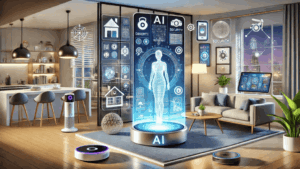Natural calamities strike with alarming speed, leaving behind devastation. Natural disasters such as hurricanes and earthquakes annually result in the displacement of millions of people and the deaths of thousands. However, artificial intelligence (AI) is becoming a silent hero amid this mayhem, anticipating catastrophes, organizing rescue efforts, and even averting deaths before they occur.
AI helps communities stay safer, governments prepare better, and first responders act more quickly by processing massive volumes of data in real time. However, in what specific ways is AI changing disaster response? Let’s examine the life-saving ways artificial intelligence is altering the landscape when nature strikes most severely, from robotic rescuers to early warning systems.
Early Warning Systems Driven by AI:
In a disaster, mere seconds can make a significant impact. Because AI can evaluate seismic data, weather patterns, and satellite pictures more quickly than humans ever could, it enhances early warning systems. Organizations such as Google and the USGS utilize AI to detect early tremors and alert devices before the onset of shaking. AI algorithms use river levels and rainfall data to forecast overflow hours ahead of time during floods. Numerous lives have already been saved by Japan’s AI-powered tsunami warnings, which provide coastal towns with vital extra time to flee. AI makes sure individuals avoid danger before it’s too late by identifying it early.
AI and Drones in Search and Rescue:
Finding survivors as soon as possible after a calamity strikes is a race against time. Drones using artificial intelligence (AI) are transforming search and rescue by more quickly and safely scouring disaster areas than human teams. These drones can identify survivors in flooded areas or locate body heat behind debris thanks to their thermal imaging and machine learning capabilities. Drones equipped with AI mapping assisted in locating trapped individuals in the worst-affected areas of Puerto Rico following Hurricane Maria. During communication outages, some drones even set up Wi-Fi networks or drop emergency supplies. AI-powered drones significantly boost survival chances during the crucial first 72 hours by covering large areas in a matter of minutes.
Machine Learning for Disaster Hotspot Prediction:
AI assists in identifying the most vulnerable locations before a disaster occurs because not all areas are equally at risk. Machine learning models forecast which neighborhoods are most likely to flood, burn, or collapse during an earthquake by examining past data, urban infrastructure, and climate trends. While city planners use this data to highlight infrastructure weaknesses, insurance firms utilize it to advise homeowners. AI fire-risk maps assist California firefighters in allocating resources ahead of the start of the wildfire season. In addition to saving lives, this proactive strategy prevents billions of dollars in avoidable harm.
AI Chatbots for Emergency Responses:
When phone lines go down, AI can keep communications going. Emergency chatbots, utilizing natural language processing (NLP), can transmit and receive messages through social media or text messaging, even during network saturation. During Hurricane Harvey, AI chatbots helped victims inform rescuers of their whereabouts and needs. Other approaches include filtering important messages through the noise of social media or translating emergency calls into multiple languages. Even when traditional systems fail, AI keeps communications going amid the chaos, so no call for help goes unnoticed.
Robot Rescuers in Dangerous Environments:
In dangerous disaster zones where humans cannot survive, we deploy AI robots. While amphibious robots traverse flooded neighborhoods, snake-like robots crawl over collapsed buildings in search of survivors. AI machines can measure radiation levels at nuclear accidents like Fukushima without endangering human lives. MIT’s cheetah robot can deliver medical supplies and drive through rubble. These robotic rescuers are still in the early stages of development, but they are already proving invaluable when people are caught in potentially deadly situations where every second counts.
Improving Evacuation Routes with AI:
Poor evacuation planning can have deadly consequences. Artificial intelligence can instantly analyze traffic, road damage, and population behavior to optimize escape routes. During the 2020 Australian bushfires, AI algorithms helped evacuate people away from busy routes and fires. Similar technology helped Florida residents evacuate Hurricane Ian along the least congested routes. Some cities are increasingly using AI simulations to pre-evaluate evacuation strategies and identify bottlenecks. AI can effectively guide people to safe areas, preventing traffic from becoming dangerous again.
Disaster Damage Assessment Powered by AI:
Knowing where to send aid after a tragedy is critical. By analyzing satellite and drone images, AI can locate collapsed buildings, blocked highways, and flooded areas faster than human teams can. After the 2023 earthquake in Turkey and Syria, AI processed thousands of images in hours, compared to weeks for humans. This rapid assessment helps prioritize medical aid, food drops, and reconstruction efforts where they’re needed most. AI can also help keep rescue workers safe by detecting secondary risks, such as gas leaks and robberies.
Conclusion:
While natural disasters will always occur, AI is tipping the balance in humanity’s favor. AI is revolutionizing our ability to predict, survive, and recover from disasters. From providing early warnings to guiding robots through ruins, AI is making it possible. Artificial intelligence is no longer assisting us in coping with natural disasters such as hurricanes and earthquakes, which are beyond our control. As these technologies evolve, they will reduce suffering, save more lives, and help communities rebuild smarter. AI is proving to be the most powerful ally in the conflict between human ingenuity and the wrath of nature, transforming a story of resilience and hope into something that once seemed doomed to fail.
FAQs:
1. What role does AI play in predicting natural disasters?
AI uses machine learning to assess seismic activity, weather data, and historical patterns to predict disasters like earthquakes, floods, and wildfires earlier than traditional methods.
2. Can AI provide immediate relief during disasters?
Yes—AI is accelerating life-saving decisions during disasters by coordinating drones, optimizing evacuations, and quickly processing emergency signals.
3. Will AI rescue robots replace humans?
No, they support human teams in entering dangerous areas that are not safe for humans, such as radiation zones or collapsed buildings.
4. How reliable are AI disaster warnings?
While not perfect, AI models used for tsunami warnings are currently over 90% accurate, and the number of false alarms is decreasing as technology improves.
5. Is AI useful after a disaster?
It can assess damage, distribute relief supplies efficiently, and even help plan reconstruction to prevent future disasters.




